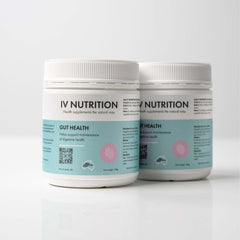In today’s fast-paced, convenience-focused world, many people unknowingly neglect one of the most foundational elements of digestive health: dietary fibre.
Fibre isn’t just “roughage” that helps you go to the bathroom—it’s a biologically critical compound that plays a central role in maintaining bowel health, microbial balance, immune function, and systemic inflammation. When fibre is lacking, the consequences often show up slowly: irregular bowel movements, bloating, fatigue, low immunity, and, over time, chronic conditions.
In this professional, science-backed guide, we’ll explore why fibre is essential for bowel health, the different types of fibre and their functions, and how you can use dietary and supplemental fibre—especially virgin-manufactured sugarcane prebiotic fibre from IV Nutrition—to restore regularity, balance your microbiome, and support long-term gut health.
Bonus: IV Nutrition is offering 100% off your first tub of their signature prebiotic fibre blend when you subscribe.
→ Claim your offer here
Table of Contents
-
What Is Fibre and Why Is It Crucial for Bowel Health?
-
Understanding the Two Main Types of Fibre
-
Fibre’s Role in Gut Motility and Regularity
-
Fibre and the Gut Microbiome: Feeding the Right Bacteria
-
The Impact of Fibre on Inflammation and Immunity
-
Signs You May Be Fibre Deficient
-
How Much Fibre Do You Actually Need?
-
Prebiotic Fibre: A Key Player in Digestive Restoration
-
The Power of Virgin Sugarcane Prebiotic Fibre from IV Nutrition
-
Easy Ways to Add More Fibre to Your Diet
-
Caution: Increasing Fibre the Right Way
-
Final Thoughts: Fibre Is the Backbone of Bowel Health
1. What Is Fibre and Why Is It Crucial for Bowel Health?
Dietary fibre refers to the indigestible parts of plant foods. While it doesn’t get broken down or absorbed in the stomach or small intestine, it plays a vital role as it travels through the gut—especially the large intestine.
In the colon, fibre:
-
Adds bulk to stool
-
Promotes regular elimination
-
Feeds beneficial gut bacteria
-
Supports the mucosal barrier
-
Regulates bowel pH
-
Influences hormonal and immune signals
Without adequate fibre, waste can stagnate in the colon, allowing toxins to be reabsorbed into the bloodstream, contributing to fatigue, inflammation, and sluggish digestion.
2. Understanding the Two Main Types of Fibre
All fibre isn’t created equal. There are two primary categories—each with its own unique role.
| Fibre Type | Description | Key Function |
|---|---|---|
| Soluble Fibre | Dissolves in water and forms a gel-like substance | Slows digestion, softens stool |
| Insoluble Fibre | Does not dissolve in water | Adds bulk to stool, speeds up transit |
Most whole plant foods contain both, but their ratios vary. For optimal bowel health, a combination of both is ideal.
Soluble fibre also plays a unique prebiotic role, which we’ll explore in depth shortly.
3. Fibre’s Role in Gut Motility and Regularity
One of fibre’s most obvious benefits is that it supports regular bowel movements.
When fibre reaches the colon:
-
Insoluble fibre increases stool bulk and stimulates peristalsis (the wave-like muscle contractions that move waste)
-
Soluble fibre holds water, creating softer, easier-to-pass stools
-
A balanced intake prevents both constipation and diarrhoea
Without sufficient fibre, stool may sit in the colon for too long, becoming dry and hard—resulting in straining, bloating, and potentially hemorrhoids or diverticulosis over time.
4. Fibre and the Gut Microbiome: Feeding the Right Bacteria
Your colon is home to trillions of bacteria, known collectively as the gut microbiome. This ecosystem is essential for everything from digestion and nutrient absorption to mood and immune regulation.
But here’s the catch: your gut bacteria need to eat too—and fibre is their primary food source.
Prebiotic Fibre: Fuel for Good Bacteria
Prebiotic fibres (a type of soluble fibre) are fermented by beneficial gut microbes, producing short-chain fatty acids (SCFAs) like butyrate, which:
-
Lower inflammation
-
Strengthen the gut lining
-
Regulate immune function
-
Support energy metabolism
Without prebiotics, your beneficial bacteria decline, while opportunistic strains (like Candida or E. coli) may thrive.
5. The Impact of Fibre on Inflammation and Immunity
Emerging research shows that fibre does more than just improve digestion—it also modulates systemic inflammation through the gut-immune connection.
How?
-
SCFAs (produced from fibre fermentation) reduce inflammatory cytokines
-
Fibre supports the gut lining, preventing leaky gut and immune overactivation
-
A balanced microbiome influences tolerance, reducing food sensitivities and autoimmunity risks
People with low fibre intake often experience chronic low-grade inflammation that manifests as fatigue, brain fog, joint pain, or skin flare-ups.
6. Signs You May Be Fibre Deficient
Most adults aren’t getting enough fibre, especially those eating a standard Western diet.
Here are common signs you may be fibre-deficient:
-
Infrequent bowel movements (less than once per day)
-
Small, hard, or pellet-like stools
-
Frequent bloating or incomplete elimination
-
Sugar cravings or blood sugar crashes
-
Skin breakouts or dull complexion
-
Low energy and mental fog
-
Increased food sensitivities or gut irritability
If you experience any of these, fibre is likely a missing link.
7. How Much Fibre Do You Actually Need?
The recommended daily intake for fibre is:
-
Women: 25–28 grams/day
-
Men: 30–38 grams/day
But studies suggest that most people get less than 15 grams—barely half the target. And in times of gut dysfunction, your needs may be even higher.
For optimal gut health, aim for at least 30 grams/day, with a combination of soluble, insoluble, and prebiotic fibre.
8. Prebiotic Fibre: A Key Player in Digestive Restoration
Prebiotic fibres differ from general dietary fibre because they’re specifically fermented by beneficial bacteria. They’re not just passive—they’re actively nourishing your internal ecosystem.
Benefits of Prebiotic Fibre:
-
Improves stool consistency without being harsh
-
Reduces bloating by feeding the right microbes
-
Enhances microbial diversity (linked to better health outcomes)
-
Promotes production of anti-inflammatory SCFAs like butyrate
-
Helps rebuild the gut lining
The best part? Prebiotics work gently and naturally, making them ideal for people with sensitive digestion, IBS, or inflammatory gut conditions.
But not all prebiotic supplements are created equal.
9. The Power of Virgin Sugarcane Prebiotic Fibre from IV Nutrition
IV Nutrition’s Virgin-Manufactured Sugarcane Prebiotic Fibre is a uniquely natural solution designed for daily gut support—without synthetic fillers or bloating.
Why It Works:
-
Virgin-extracted from whole sugarcane – retaining its full-spectrum, bioavailable fibre matrix
-
Rich in soluble prebiotics – gently fermented in the colon for optimal SCFA production
-
Non-GMO and chemical-free – perfect for clean, clinical-grade gut support
-
Supports regularity without gas or cramping
Unlike many fibre powders that bulk up stool too aggressively or contain artificial additives, this sugarcane-derived fibre is balanced, bioavailable, and microbiome-friendly.
Special Offer: 100% Off Your First Tub
Ready to restore your bowels naturally?
You can now try IV Nutrition’s prebiotic fibre with 100% off your first tub when you subscribe.
→ Click here to claim your free tub
A small, daily scoop may be the missing piece in your bowel health puzzle.
10. Easy Ways to Add More Fibre to Your Diet
Beyond supplementation, here’s how to naturally boost your fibre intake:
| Food Type | Examples |
|---|---|
| Legumes | Lentils, chickpeas, black beans, peas |
| Whole grains | Quinoa, oats, barley, brown rice |
| Fruits | Apples (with skin), pears, berries, bananas |
| Vegetables | Broccoli, carrots, artichokes, leafy greens |
| Nuts & seeds | Chia seeds, flaxseed, almonds, pumpkin seeds |
Tips:
-
Start your day with a fiber-rich smoothie (add chia, flax, or oats)
-
Snack on raw veggies with hummus or guacamole
-
Replace white rice or pasta with quinoa or barley
-
Add IV Nutrition’s prebiotic fibre to your coffee, oatmeal, or shake
11. Caution: Increasing Fibre the Right Way
While fibre is essential, suddenly increasing your intake too quickly can cause temporary bloating or discomfort—especially if your gut is currently inflamed or imbalanced.
How to Safely Introduce Fibre:
-
Go slow: Increase by 5 grams every few days
-
Hydrate: Drink plenty of water to help fibre move through your system
-
Chew thoroughly: Especially raw vegetables and seeds
-
Support gut flora: Use prebiotics like sugarcane fibre to feed the right microbes
-
Avoid ultra-processed fibre supplements that contain gums, fillers, or synthetic agents
Gentle, natural fibre sources like those from whole foods or sugarcane make this transition smoother and more sustainable.
12. Final Thoughts: Fibre Is the Backbone of Bowel Health
Fibre isn’t just a side note in nutrition—it’s foundational to the entire gut ecosystem. From regular bowel movements and microbial health to inflammation regulation and immune resilience, every major function of the digestive system depends on a steady intake of quality fibre.
But modern diets, stress, medications, and processed food often leave the gut depleted and imbalanced.
That’s why targeted support—like virgin-manufactured sugarcane prebiotic fibre—can be a game-changer. It’s not about taking another supplement. It’s about restoring the rhythm of digestion, naturally.
If your bowels have been sluggish, sensitive, or unpredictable, this may be your next best step.





